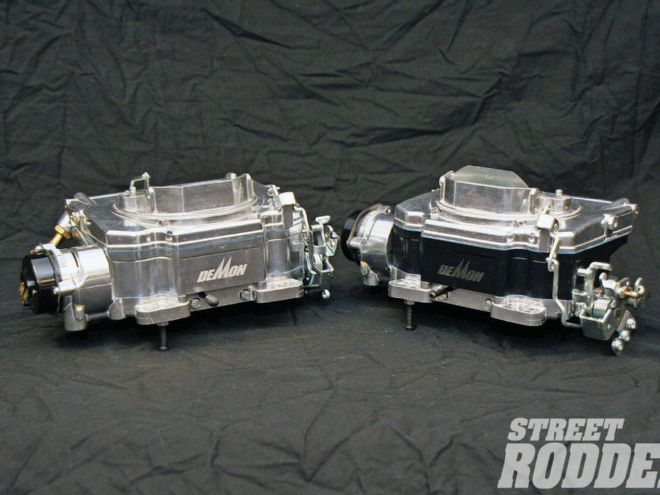
There's nothing new under the sun, and that's especially true with carburetors. Carbs have been designed, developed, and refined for the last hundred years, so pretty much everything you can do with them has been done, right?
Well, yes and no.
Up until now, most carbs, including the performance models, have been OE-based, or revisions of OE designs. From the 97 to the Double Pumper, from the AFB to the Q-Jet to the ThermoQuad, they've all built on one another, and the lineage goes directly back to Original Equipment.
The new Street Demon series of carbs is exciting to us because it almost looks like they took a "clean slate" approach with designing a carb, pulling several features from existing carb technology, but put them together in a way that hasn't been done before.
There are a number of things we like about it, most of which center around the simplicity of its design. There's a certain elegance in simplicity, and these carbs have it.
There have been other carbs in the past that have been "top load" styles, with a top of the body coming off to access the internal components, but the Street Demon has three main pieces: the top, the bowl/body, and the throttle plate. Among other things, this design only has one place for them to leak fuel—the one-piece horizontal gasket on top of the bowls, where the fuel will have to travel up before it can weep past the gasket.
The other thing we really like about it is the optional phenolic main body. We'll admit to being fans of the old Chrysler Thermoquad for this reason, and the fuel-insulating properties of its plastic body. Insulating the engine heat from the fuel is always a good thing, and the fuel bowls being made of plastic material is going to do a great job of keeping the fuel cooler. It's an obvious advantage if you're hot lapping at the dragstrip, but we're more enthused by the idea of eliminating a source of vapor locking in heavy summer traffic.
Besides the three-piece design allowing easy access to internal parts, and the phenolic main body, the biggest difference over other carbs is the three-barrel design. We don't have flow numbers on it, but dyno testing on a couple of 409s (one a stroked street engine, the other a big 509-inch full race motor) at Lamar Walden Automotive shows them to flow like monsters, making more power than modern AFB-style carbs with similarly advertised cfm numbers. Because of the huge rear secondary, the primaries are smaller than a similarly rated four-barrel carb, much like a Quadrajet or Thermoquad. This should help in dialing in the carbs for around-town driving on the smaller primaries, while giving a lot more flow when the pedal is mashed.
Clean design, easy to tune, leak resistant, a bright finish, and a host of other features make this carb a great solution for street rods, hot rods, daily drivers, and race cars.
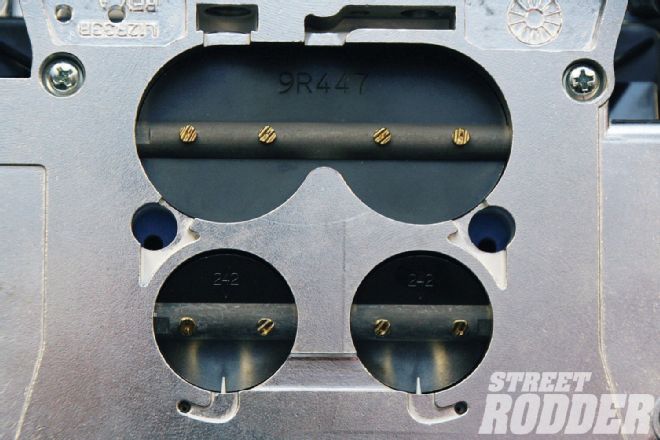 The most obvious feature of the Street Demon is the three-barrel design. Demon calls that third barrel the “Goggle Valve Secondary”, due to its eye-goggle shape.
The most obvious feature of the Street Demon is the three-barrel design. Demon calls that third barrel the “Goggle Valve Secondary”, due to its eye-goggle shape.
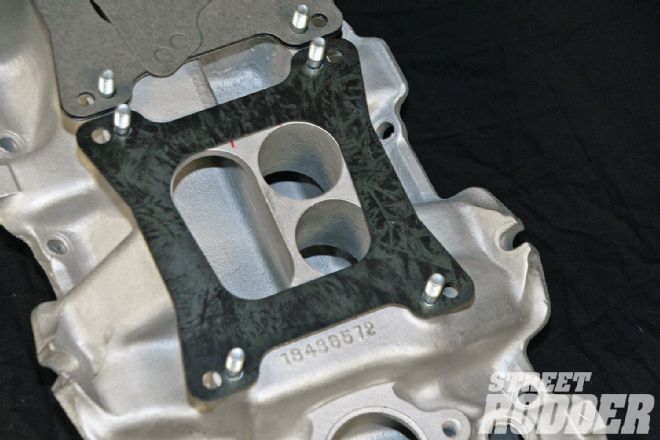 The dip in the Goggle Valve is to clear the plenum divider in an intake. The carb comes with a metal shim to give it an extra little bit of clearance, and to give the gaskets a uniform mating surface.
The dip in the Goggle Valve is to clear the plenum divider in an intake. The carb comes with a metal shim to give it an extra little bit of clearance, and to give the gaskets a uniform mating surface.
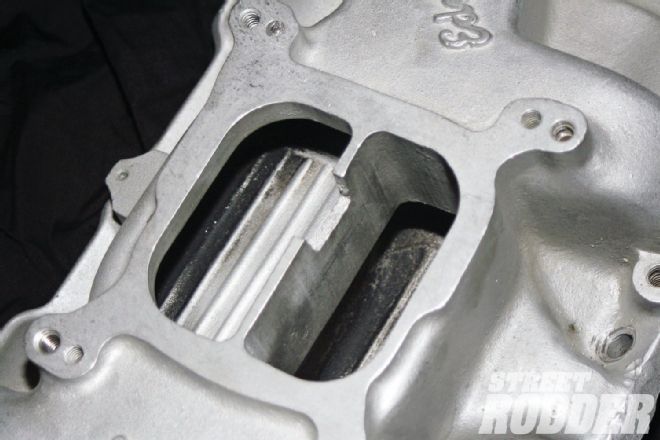 This is not the first foray into three-barrel carbs. Holley had a large-cfm three-barrel in the ’60s and ’70s, and we owe “the notch” to it. Edelbrock’s original single four-barrel intake manifold was called the “_4B”: C4B for Chevy four-barrel, F4B for Ford four-barrel. The carb mounting pad was originally a four-hole design, later changed to a two-hole divided plenum. When the Holley three-barrel carb came out, the aftermarket intakes got a notch in the plenum divider to clear the rear “barn door” throttle plate and the intake was designated “_3B”.
This is not the first foray into three-barrel carbs. Holley had a large-cfm three-barrel in the ’60s and ’70s, and we owe “the notch” to it. Edelbrock’s original single four-barrel intake manifold was called the “_4B”: C4B for Chevy four-barrel, F4B for Ford four-barrel. The carb mounting pad was originally a four-hole design, later changed to a two-hole divided plenum. When the Holley three-barrel carb came out, the aftermarket intakes got a notch in the plenum divider to clear the rear “barn door” throttle plate and the intake was designated “_3B”.
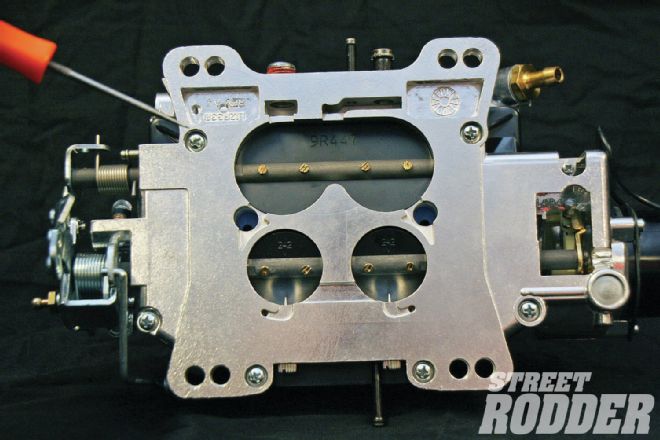 The primary jets are a unique design, while the secondary jets are standard Holley. The passage to the accelerator pump is a hard composite line. The whole thing is really very simple in design.
The primary jets are a unique design, while the secondary jets are standard Holley. The passage to the accelerator pump is a hard composite line. The whole thing is really very simple in design.
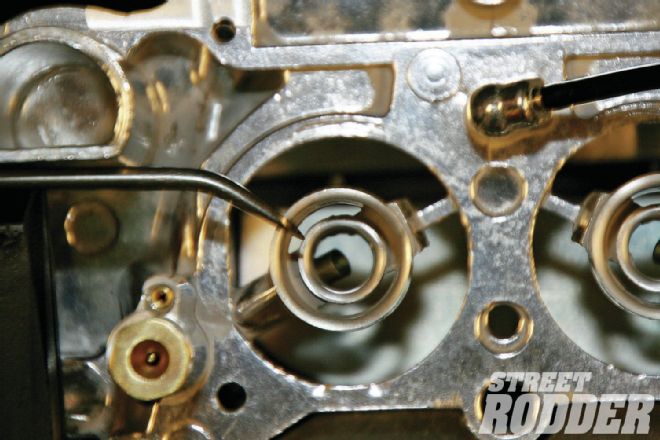 The booster venturii have a unique design to them—rather than being the typical single flume, these are doubled.
The booster venturii have a unique design to them—rather than being the typical single flume, these are doubled.
 The body of the Street Demon has three main pieces, held together by six bolts—four from the bottom, two from the top.
The body of the Street Demon has three main pieces, held together by six bolts—four from the bottom, two from the top.
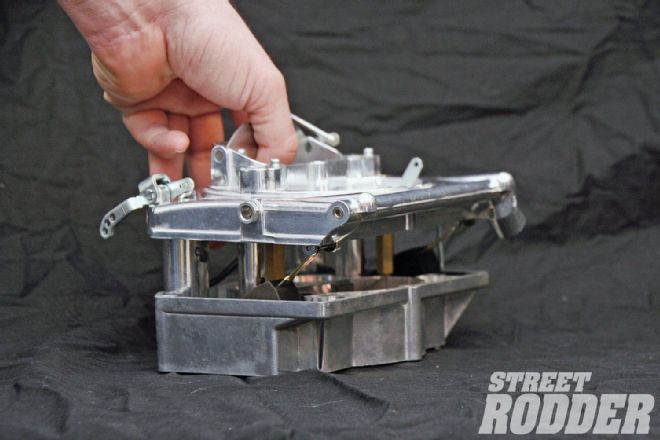 Remove the bolts, and all the “guts” lift off with the top of the carb’s body—float bowls, jets, metering rods, accelerator pump, and so on, are all accessible. This makes jet and needle changes incredibly easy, and clean, because the components are right there, while the bowls don’t need to be drained. Initially, Rob and Lamar Walden found it was a pain because the four screws in the bottom necessitated removing the carb every time for changes while tuning on the dyno—until they discovered the four screws in the bottom can be left out during tuning, as the two through the top will hold the carb together, allowing them to keep the carb bolted to the intake, and just remove the top.
Remove the bolts, and all the “guts” lift off with the top of the carb’s body—float bowls, jets, metering rods, accelerator pump, and so on, are all accessible. This makes jet and needle changes incredibly easy, and clean, because the components are right there, while the bowls don’t need to be drained. Initially, Rob and Lamar Walden found it was a pain because the four screws in the bottom necessitated removing the carb every time for changes while tuning on the dyno—until they discovered the four screws in the bottom can be left out during tuning, as the two through the top will hold the carb together, allowing them to keep the carb bolted to the intake, and just remove the top.
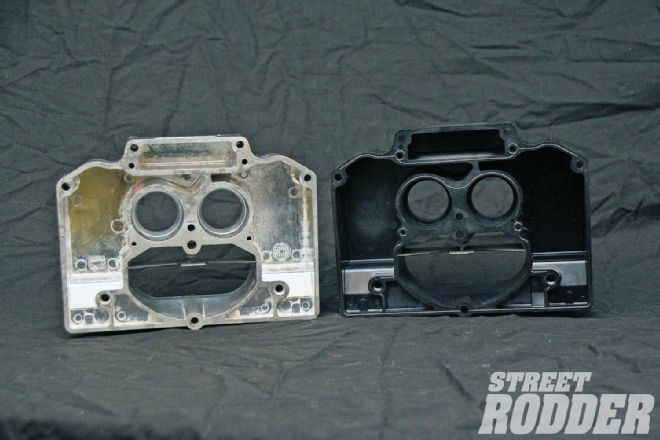 The main body is a one-piece design, with the venturi and float bowls integrated in the aluminum or polymer body. The polymer body is obviously reminiscent of the Mopar ThermoQuad. The one-piece body eliminates leaking bowl gaskets.
The main body is a one-piece design, with the venturi and float bowls integrated in the aluminum or polymer body. The polymer body is obviously reminiscent of the Mopar ThermoQuad. The one-piece body eliminates leaking bowl gaskets.
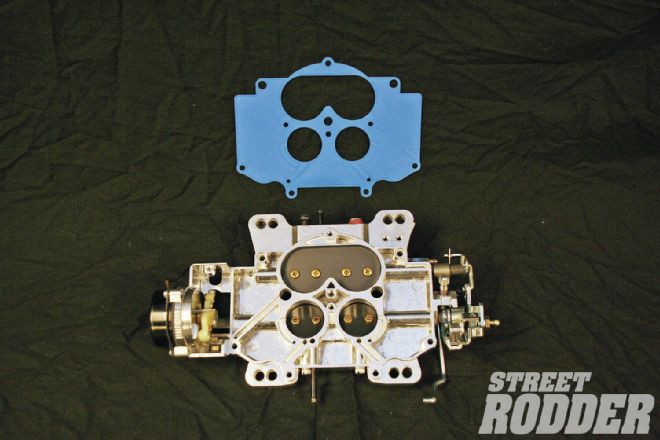 A one-piece, reusable gasket seals the body to the base.
A one-piece, reusable gasket seals the body to the base.
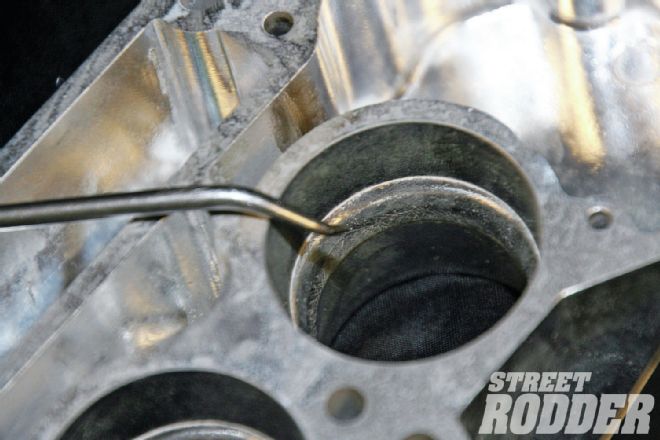 In the throat of the main body, there is a step that, combined with the doubled boosters, creates the “triple stack” primary circuit. Company literature says the triple stack design delivers crisp throttle response and driveability, superior fuel atomization, and improved fuel economy.
In the throat of the main body, there is a step that, combined with the doubled boosters, creates the “triple stack” primary circuit. Company literature says the triple stack design delivers crisp throttle response and driveability, superior fuel atomization, and improved fuel economy.
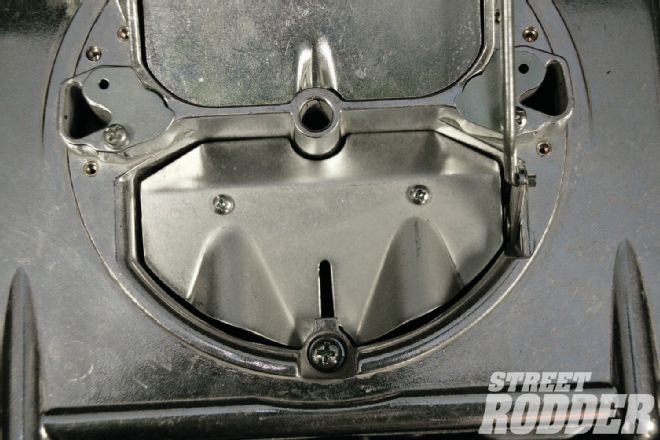 The secondary air valve control is spring loaded and vacuum operated.
The secondary air valve control is spring loaded and vacuum operated.
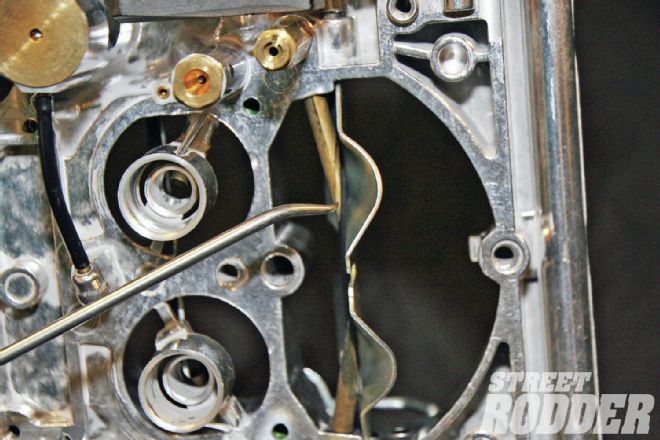 Note the contours on the air valve control: these contours direct air over the secondary booster tubes—the design funnels more air over the tubes, creating a venturi affect and gives a more positive, crisper signal and response. Having a flat plate would require moving the tube outlets back, away from the center of the barrel, or if left in place the flat plate would choke off the air.
Note the contours on the air valve control: these contours direct air over the secondary booster tubes—the design funnels more air over the tubes, creating a venturi affect and gives a more positive, crisper signal and response. Having a flat plate would require moving the tube outlets back, away from the center of the barrel, or if left in place the flat plate would choke off the air.
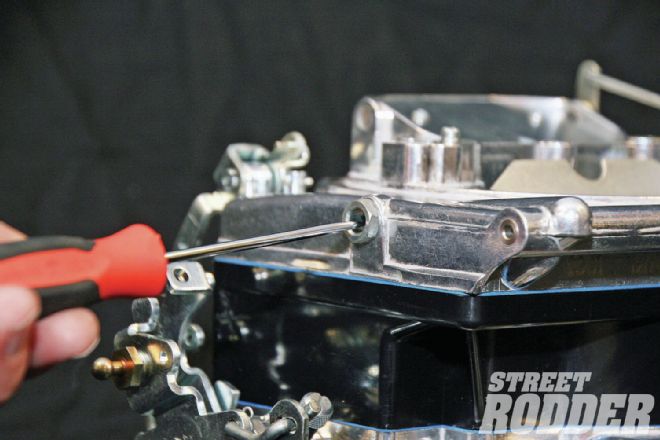 The secondary air valve control is spring loaded, and fully adjustable—a screw and locking nut allow you to tune the tension on the torsion spring for primary-to-secondary throttle “tip-in”, independent of the throttle-opening rate.
The secondary air valve control is spring loaded, and fully adjustable—a screw and locking nut allow you to tune the tension on the torsion spring for primary-to-secondary throttle “tip-in”, independent of the throttle-opening rate.
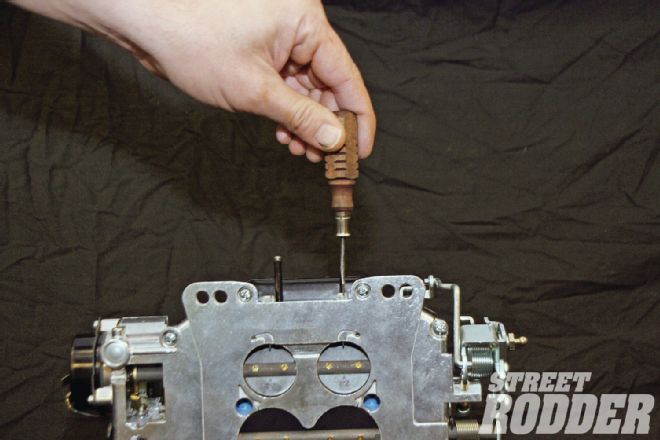 The idle air bleeds are also adjustable.
The idle air bleeds are also adjustable.
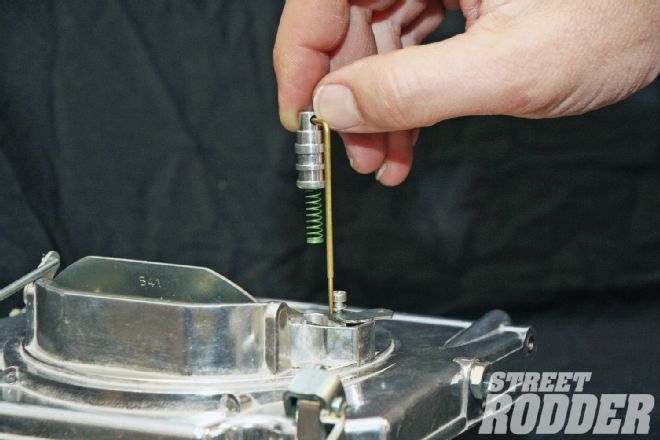 Metering rods are easily accessed, the same way they are on an AFB-style carburetor. Metering rods are two-step design.
Metering rods are easily accessed, the same way they are on an AFB-style carburetor. Metering rods are two-step design.
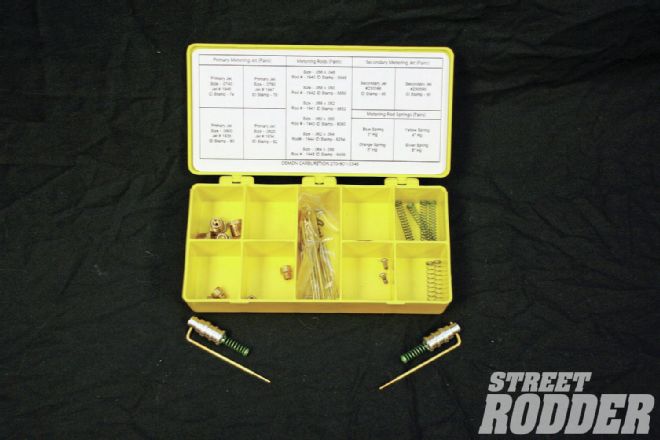 Full jet, metering rod, and spring kits are available, with eight different sets of metering rods, four different vacuum step-up springs, and multiple primary and secondary jet sizes.
Full jet, metering rod, and spring kits are available, with eight different sets of metering rods, four different vacuum step-up springs, and multiple primary and secondary jet sizes.
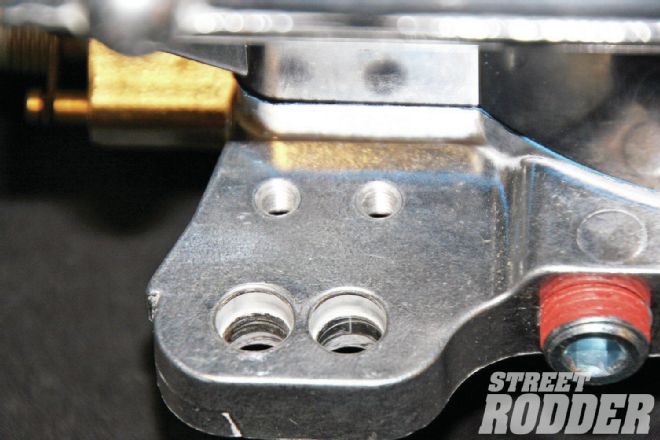 Plenty of options are available for the Street Demon—the base is drilled for a TPS switch or Ford auto trans kick down spring and perch kit. Fast idle solenoids and throttle and kickdown cable brackets are also available.
Plenty of options are available for the Street Demon—the base is drilled for a TPS switch or Ford auto trans kick down spring and perch kit. Fast idle solenoids and throttle and kickdown cable brackets are also available.
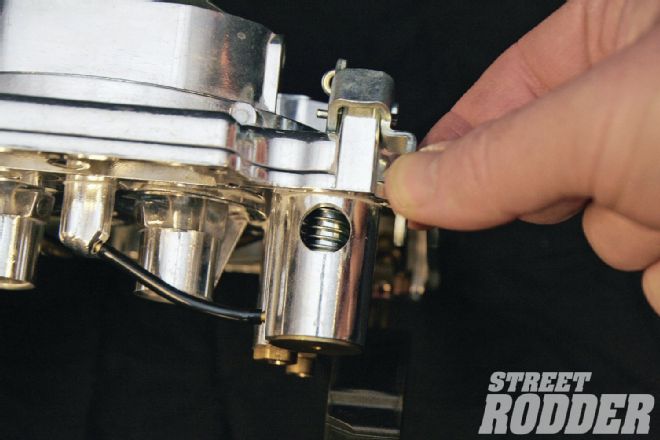 The accelerator pump is more intuitive than AFBs—instead of the spring being under the pump, it’s on top, which allowed the assembly to be made into the top of the body instead of the bottom. It comes out with everything else when you pull the top of the body off, so you don’t have to dig down into the bowls and body like you do with an AFB.
The accelerator pump is more intuitive than AFBs—instead of the spring being under the pump, it’s on top, which allowed the assembly to be made into the top of the body instead of the bottom. It comes out with everything else when you pull the top of the body off, so you don’t have to dig down into the bowls and body like you do with an AFB.
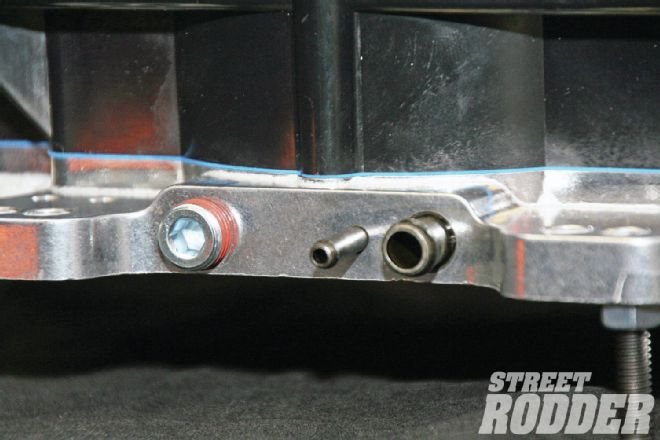 A full array of vacuum ports is found on the carb.
A full array of vacuum ports is found on the carb.
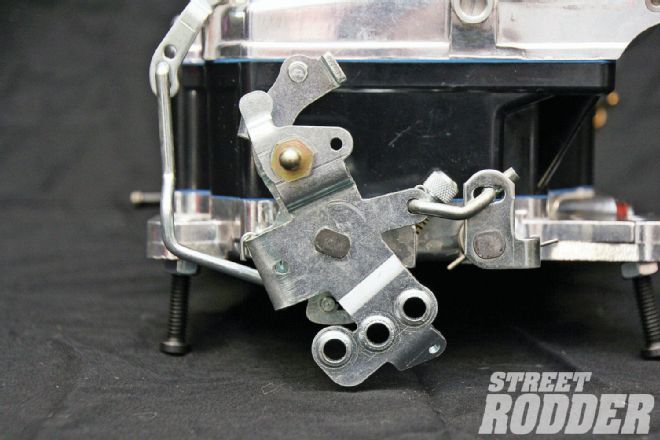 A bolt-on GM throttle cable adapter lever, and Chrysler throttle stud are available, while the carb comes with a Ford linkage arm.
A bolt-on GM throttle cable adapter lever, and Chrysler throttle stud are available, while the carb comes with a Ford linkage arm.
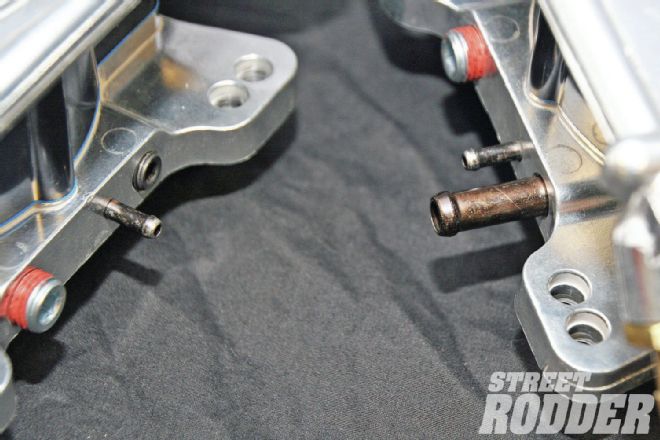 When running them as a dual-carb setup, Walden found the vacuum port needed to be removed and the hole plugged.
When running them as a dual-carb setup, Walden found the vacuum port needed to be removed and the hole plugged.
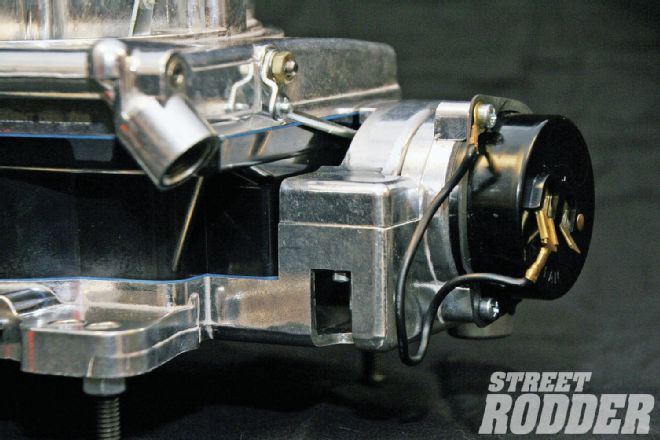 Choke is electric, with the housing being integrally machined into the throttle-plate portion of the body.
Choke is electric, with the housing being integrally machined into the throttle-plate portion of the body.
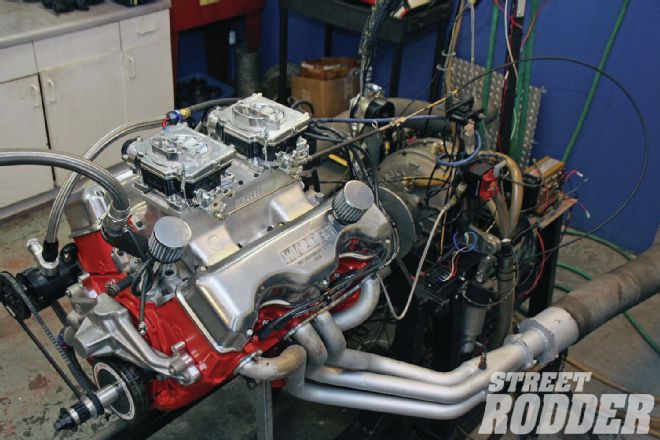 On the dyno, the Street Demons made more power than modern AFB-style carbs on a hot street 409 engine. Showing these carbs are excellent for all-out performance applications, Walden got the first two 750-cfm carbs for a 509-inch 409 race engine with original high-port Z-11 heads. Walden built the engine with an original Z-11 intake and modern AFBs, and ran out of carb. After adding a pair of 625-cfm Street Demons, they ran out of intake, so they bolted on one of their own intakes, ran out of carb again, and added the 750-cfm Demons—when it was done, they’d picked up more than 100 hp over the high-zoot factory mini-tunnel ram and modern AFBs—which was previously one of the best combos available for a 409.
On the dyno, the Street Demons made more power than modern AFB-style carbs on a hot street 409 engine. Showing these carbs are excellent for all-out performance applications, Walden got the first two 750-cfm carbs for a 509-inch 409 race engine with original high-port Z-11 heads. Walden built the engine with an original Z-11 intake and modern AFBs, and ran out of carb. After adding a pair of 625-cfm Street Demons, they ran out of intake, so they bolted on one of their own intakes, ran out of carb again, and added the 750-cfm Demons—when it was done, they’d picked up more than 100 hp over the high-zoot factory mini-tunnel ram and modern AFBs—which was previously one of the best combos available for a 409.
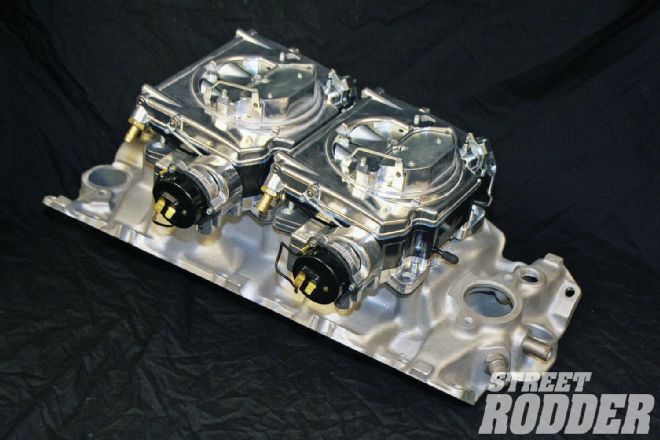 This is one of the great aspects of the Street Demon carbs—unlike regular Holley carbs, these will bolt to factory GM 2x4 intake manifolds. Previously, only modern AFBs and original carbs could be used due to spacing.
This is one of the great aspects of the Street Demon carbs—unlike regular Holley carbs, these will bolt to factory GM 2x4 intake manifolds. Previously, only modern AFBs and original carbs could be used due to spacing.
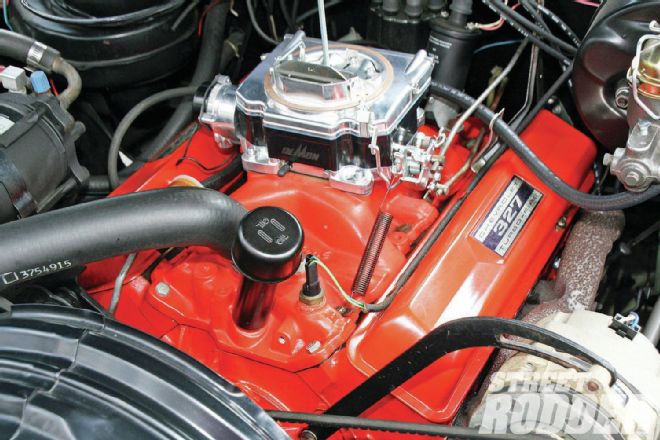 Rob Walden dropped a Street Demon on the mild 327 in his cream-puff original ’63 Bel Air, and was very impressed with its performance in Atlanta’s traffic. We can’t imagine anything better for stop-and-go traffic on a hot day than that phenolic main body.
Rob Walden dropped a Street Demon on the mild 327 in his cream-puff original ’63 Bel Air, and was very impressed with its performance in Atlanta’s traffic. We can’t imagine anything better for stop-and-go traffic on a hot day than that phenolic main body.